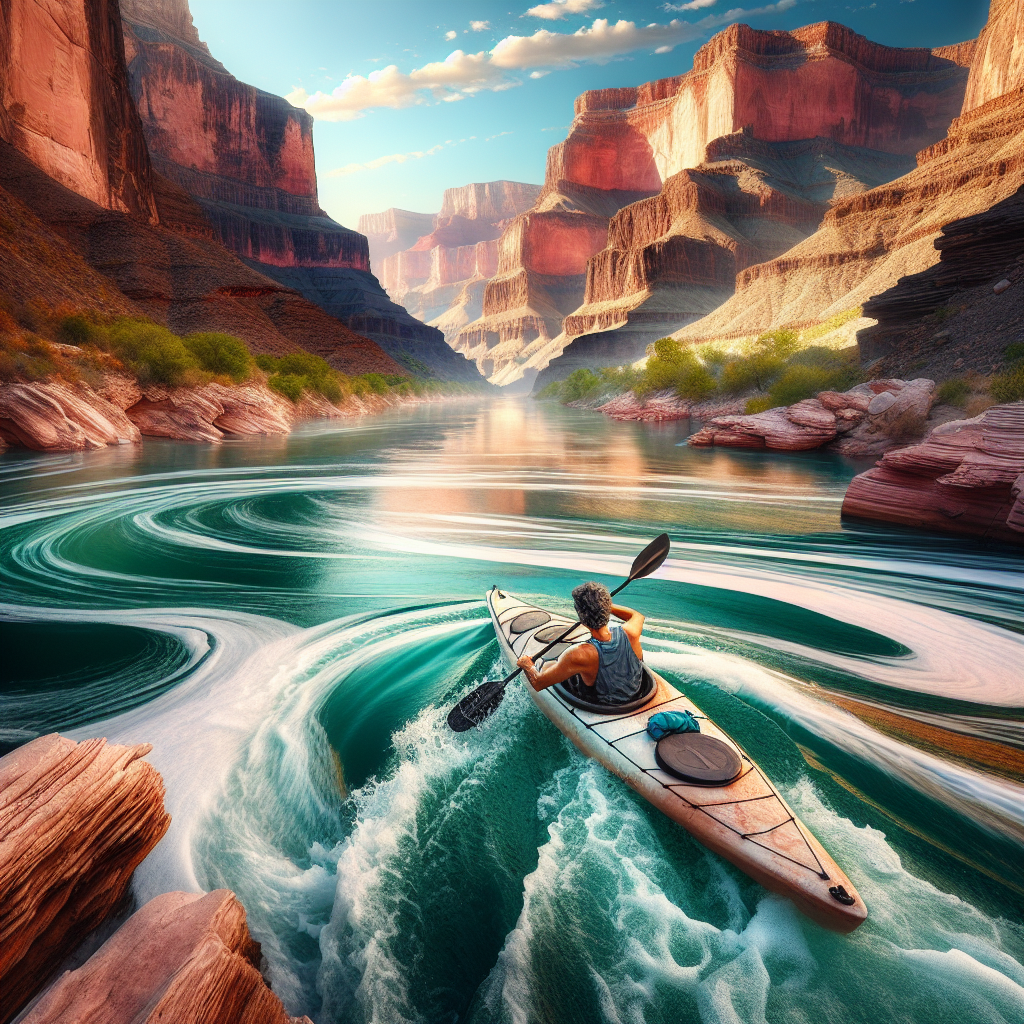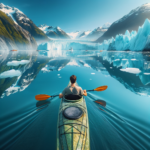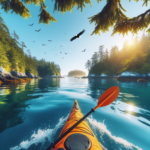Kayaking in Colorado River, Grand Canyon, USA
Introduction to Kayaking
Kayaking is an exhilarating outdoor activity that has gained immense popularity over the years. It offers a unique way to explore nature, providing both adventure and tranquility. Whether you’re navigating through calm waters or tackling challenging rapids, kayaking delivers a thrilling experience that appeals to both beginners and seasoned paddlers. The sport’s versatility and the sense of freedom it offers make it a favorite among outdoor enthusiasts.
In this article, we will spotlight the unique features of kayaking in the Colorado River, Grand Canyon, USA. This destination is renowned for its breathtaking landscapes, diverse wildlife, and challenging water conditions, making it a fantastic spot for kayaking enthusiasts. We’ll delve into the specifics of what makes this location so special and provide practical information for those planning a trip.
Kayaking in the Colorado River, Grand Canyon, USA, is not just about the thrill of navigating through rapids. It’s also about immersing yourself in the natural beauty and rich history of the area. The Grand Canyon’s towering cliffs, vibrant ecosystems, and ancient geological formations create a kayaking experience like no other.
Whether you’re seeking an adrenaline-pumping adventure or a peaceful paddle through serene waters, the Colorado River in the Grand Canyon offers something for everyone. Let’s dive into the details and discover why this destination should be on every kayaker’s bucket list.
Overview of Kayaking in Colorado River, Grand Canyon, USA
The Colorado River winds its way through the Grand Canyon, carving out one of the most iconic landscapes in the world. This river is known for its challenging rapids, stunning scenery, and rich history. The Grand Canyon itself is a UNESCO World Heritage Site, attracting millions of visitors each year who come to marvel at its natural beauty and geological significance.
The climate in the Grand Canyon varies significantly depending on the time of year and elevation. Summers can be extremely hot, with temperatures often exceeding 100°F (38°C) at the bottom of the canyon. Winters, on the other hand, can be quite cold, especially at higher elevations. Spring and fall are generally considered the best times to visit, offering milder temperatures and more predictable weather conditions.
Accessing the Colorado River for kayaking typically involves a bit of planning. Most visitors start their journey at Lees Ferry, the only place within Glen Canyon where visitors can drive to the Colorado River. From there, kayakers can embark on multi-day trips through the Grand Canyon, experiencing a mix of calm waters and challenging rapids.
Historically, the Colorado River has been a vital waterway for indigenous peoples, explorers, and settlers. Today, it continues to be a popular destination for water sports enthusiasts, offering a unique blend of adventure, natural beauty, and cultural significance.
Kayaking Conditions in Colorado River, Grand Canyon, USA
The Colorado River in the Grand Canyon is renowned for its diverse and challenging water conditions. The river features a mix of calm stretches and intense rapids, making it suitable for kayakers of varying skill levels. The rapids are classified on a scale from I to X, with Class I being the easiest and Class X being extremely dangerous and typically not navigable.
Weather conditions in the Grand Canyon can vary widely throughout the year. Summers are hot and dry, with temperatures often soaring above 100°F (38°C). This can make kayaking strenuous, so it’s essential to stay hydrated and protect yourself from the sun. Winters are cooler, with temperatures occasionally dropping below freezing at night. Spring and fall offer more moderate temperatures, making them ideal seasons for kayaking.
The water levels in the Colorado River are influenced by several factors, including snowmelt from the Rocky Mountains and water releases from upstream dams. These factors can affect the river’s flow rate and the difficulty of the rapids. It’s crucial for kayakers to check current water conditions and forecasts before embarking on their trip.
Environmental factors such as water temperature, wind, and weather patterns can also impact kayaking conditions. The river’s water temperature remains relatively cold year-round, averaging around 50°F (10°C). Wind can create additional challenges, especially in open sections of the river. Being prepared for these conditions is essential for a safe and enjoyable kayaking experience.
Top Spots for Kayaking in Colorado River, Grand Canyon, USA
The Colorado River offers several prime spots for kayaking, each with its unique features and challenges. One of the most popular sections is the stretch from Lees Ferry to Phantom Ranch. This section includes some of the Grand Canyon’s most famous rapids, such as Hance Rapid and Granite Rapid, offering thrilling experiences for advanced kayakers.
Another notable spot is the section from Phantom Ranch to Diamond Creek. This stretch features a mix of challenging rapids and calmer waters, making it suitable for intermediate kayakers. The scenery in this section is particularly stunning, with towering cliffs, lush vegetation, and abundant wildlife.
For those seeking a more relaxed kayaking experience, the stretch from Diamond Creek to Lake Mead offers calmer waters and fewer rapids. This section is ideal for beginners or those looking to enjoy the Grand Canyon’s beauty at a more leisurely pace. The best time to kayak this section is during the spring or fall when temperatures are milder.
Each of these spots offers unique opportunities to experience the Grand Canyon’s diverse landscapes and ecosystems. Whether you’re navigating through challenging rapids or paddling through serene waters, kayaking in the Colorado River provides an unforgettable adventure.
Safety and Regulations
Safety is paramount when kayaking in the Colorado River, Grand Canyon, USA. The river’s challenging rapids and remote location require careful planning and preparation. It’s essential to familiarize yourself with local regulations and guidelines to ensure a safe and enjoyable trip.
Wearing appropriate safety gear is crucial. This includes a well-fitted life jacket, helmet, and protective clothing. It’s also advisable to carry a first aid kit, a whistle, and a waterproof map of the area. For multi-day trips, packing sufficient food, water, and camping gear is essential.
Understanding how to handle emergency situations is vital. This includes knowing how to perform self-rescue techniques, recognizing signs of hypothermia and heat exhaustion, and being aware of potential hazards such as flash floods and wildlife encounters. Taking a kayaking safety course can provide valuable skills and knowledge.
Local regulations may require permits for certain sections of the river, especially for multi-day trips. It’s important to obtain the necessary permits and adhere to guidelines regarding campfires, waste disposal, and wildlife protection. Respecting these regulations helps preserve the natural beauty and ecological integrity of the Grand Canyon.
Amenities and Accommodations
The Grand Canyon area offers a range of amenities and accommodations to cater to kayakers. Several rental facilities provide kayaks, safety gear, and other equipment. Guided tours are also available, offering expert knowledge and support for those new to the area or seeking a more structured experience.
Accommodation options vary from rustic camping sites to comfortable lodges and hotels. For those who prefer to camp, there are designated sites along the river, equipped with basic facilities such as restrooms and picnic tables. These sites offer a chance to immerse yourself in the natural surroundings and enjoy the tranquility of the canyon.
For a more comfortable stay, several lodges and hotels are located near the Grand Canyon. These accommodations provide amenities such as hot showers, dining options, and recreational activities. Staying in a lodge or hotel can be a great way to relax and recharge after a day of kayaking.
In addition to kayaking, the Grand Canyon area offers a variety of recreational activities. Hiking, wildlife watching, and scenic drives are popular options for those looking to explore the canyon from different perspectives. These activities provide a well-rounded experience, allowing visitors to fully appreciate the beauty and diversity of the Grand Canyon.
Environmental Considerations
Preserving the natural habitats and wildlife of the Grand Canyon is of utmost importance. Kayakers are encouraged to practice eco-friendly habits to minimize their impact on the environment. This includes packing out all trash, using biodegradable soap, and avoiding disturbing wildlife.
Sticking to designated camping sites and trails helps protect fragile ecosystems. It’s also important to respect local flora and fauna by not picking plants or feeding animals. These practices help maintain the natural balance and ensure that future generations can enjoy the beauty of the Grand Canyon.
Several conservation efforts and local projects aim to protect the Grand Canyon’s unique environment. Visitors can support these initiatives by participating in volunteer programs, donating to conservation organizations, or simply spreading awareness about the importance of preserving this natural wonder.
By following eco-friendly practices and supporting conservation efforts, kayakers can contribute to the long-term health and sustainability of the Grand Canyon. This ensures that the area remains a pristine and vibrant destination for future adventurers.
Highlights
When comparing kayaking in the Colorado River, Grand Canyon, USA, with other popular kayaking locations, several unique features stand out. The Grand Canyon’s dramatic landscapes, diverse ecosystems, and challenging rapids create a kayaking experience that is truly one-of-a-kind.
The biodiversity of the Grand Canyon is remarkable, with numerous plant and animal species that are found nowhere else in the world. This includes rare and endangered species such as the California condor and the humpback chub. Kayaking through this diverse environment offers a chance to witness these unique species in their natural habitat.
Geographically, the Grand Canyon is unparalleled. Its towering cliffs, deep gorges, and vibrant rock formations create a stunning backdrop for kayaking. The geological history of the canyon, with layers of rock dating back millions of years, adds an element of wonder and intrigue to the experience.
Historically, the Colorado River has played a significant role in shaping the Grand Canyon and supporting indigenous cultures. Kayaking through this area offers a connection to this rich history, providing a deeper appreciation for the natural and cultural significance of the Grand Canyon.
FAQ Section
- What is the best season to go kayaking in the Colorado River, Grand Canyon? The best seasons are spring and fall, offering milder temperatures and more predictable weather conditions.
- Are there beginner-friendly spots for kayaking? Yes, the stretch from Diamond Creek to Lake Mead offers calmer waters suitable for beginners.
- What should I bring for a kayaking trip? Essential items include a life jacket, helmet, protective clothing, first aid kit, whistle, waterproof map, food, water, and camping gear for multi-day trips.
- Are kayak rentals available? Yes, several rental facilities provide kayaks and safety gear.
- How can I participate in local conservation efforts? You can support conservation initiatives by participating in volunteer programs, donating to organizations, or spreading awareness about environmental preservation.
- Are guided kayaking tours available? Yes, guided tours are available and offer expert knowledge and support for a more structured experience.
- What safety measures are in place? Safety measures include wearing appropriate gear, understanding emergency procedures, and adhering to local regulations and guidelines.
Final Thoughts
Kayaking in the Colorado River, Grand Canyon, USA, is a premier destination for kayaking enthusiasts. The combination of challenging rapids, stunning scenery, and rich history creates an unforgettable experience. Whether you’re an experienced kayaker or a beginner, the Grand Canyon offers something for everyone.
It’s important to respect local guidelines and conservation efforts to preserve the natural beauty and ecological integrity of the area. By practicing eco-friendly habits and supporting conservation initiatives, we can ensure that the Grand Canyon remains a pristine destination for future generations.
In conclusion, kayaking in the Colorado River, Grand Canyon, USA, is an adventure that should not be missed. The unique landscapes, diverse wildlife, and thrilling water conditions make it a top choice for outdoor enthusiasts. So pack your gear, plan your trip, and get ready to explore the beauty and excitement of kayaking in the Grand Canyon.



